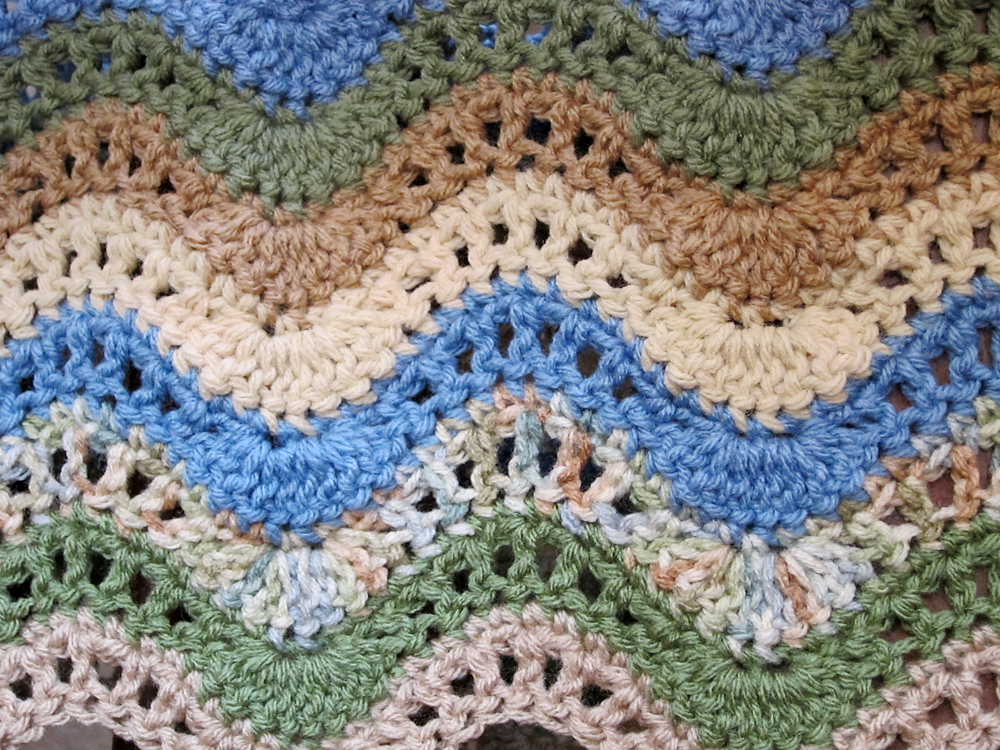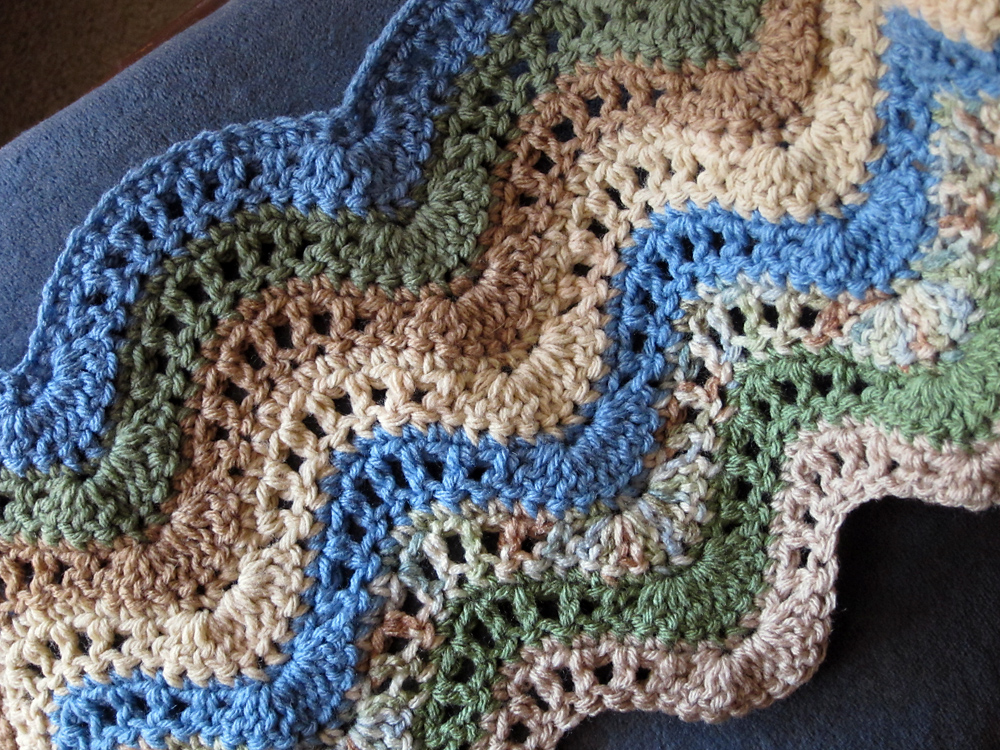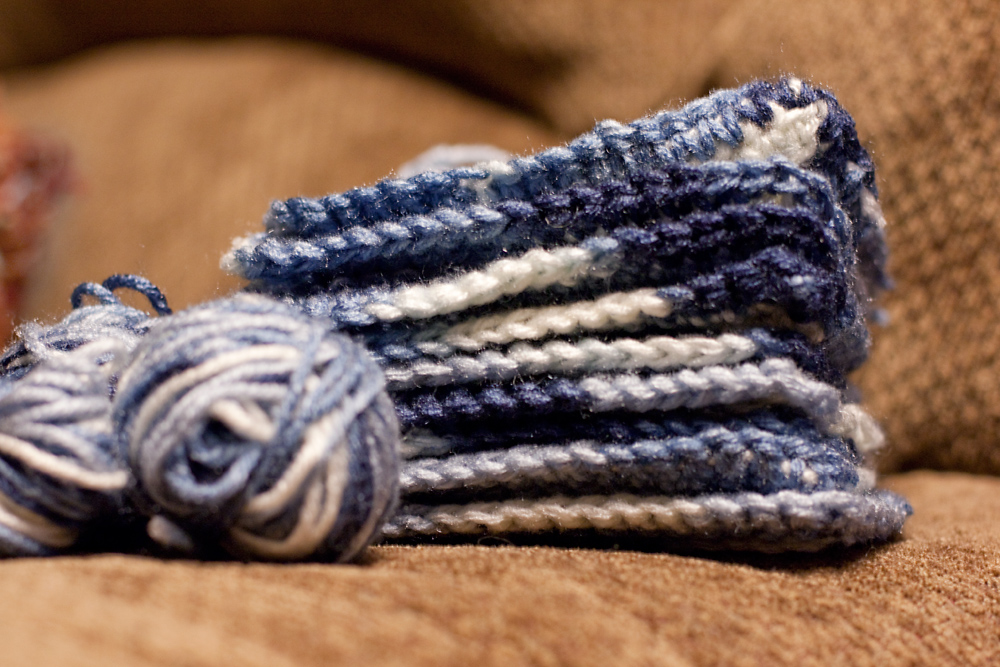So. I've fallen into the same bad habit as so many crocheters (and knitters) before me-- putting aside one project to work on another. I don't want to start a collection of UFOs (unfinished objects, to those unfamiliar with yarnese), but maybe it's impossible to avoid.
At least I still have only a mild case of UFOs. The lovely, colorful hexagon afghan has been set aside-- temporarily. I'll eventually have to look at it again, figure out a thing or two about changing colors (and whether or not you're supposed to turn your work as you make each motif), but rather than tackle those questions, I've allowed myself to be sidetracked.
First, there were a bunch of granny squares I made as I learned to crochet. The problem was, they weren't very nice. They were all of one type of variegated yarn, and I've come to realize that (in my opinion, at least), granny squares really need to be either multiple colors or a solid color. Besides the yucky effect of the variegated yarn, they were "wonky" (if an American may use the word ;o)). Some were larger than the others, because I was so inexperienced with tension and crochet in general. I could have forced them to go together, but instead, I frogged them. (Or is it only called frogging when knitters do it? (g)) Then I spent some evening TV hours happily crocheting away at dish cloths. Variegated-only dishcloths = much nicer than variegated-only granny squares!
Once I'd used up my supply of granny-square-yarn, I was left to face a dilemma: face up to my hexagon problem or start a new procrastination project. If you know me, my choice should be clear. ;o) Immediately, I began researching afghan patterns that might be acceptable for a bunch of yarn I already had on hand (and that wasn't intended for the hexagon afghan).
If I got to choose any colors I wanted for this new blanket (which I really ought to call The Procrastination Afghan, oughtn't I?), I'd pick something other than this previously purchased yarn. It's country blue, sage green, beige, "Warm Brown", "Aspen Print" (a variegated yarn in green, blue, cream/white, and light brown), and ecru (with the ones in quotation marks being the only ones I remember specifically by name). It's not that they're ugly colors-- they're just not what I'd gravitate toward, these days. Still, I think they'll make a decent afghan-- and they're already paid for, which gives them bonus points.
So, once I'd decided to make a Procrastination Afghan, I got to spend a few days looking at afghan patterns. I eliminated squares/motifs fairly quickly. After all, I'm on hiatus from a motif pattern, and I thought something that was worked in rows might be a faster, more carefree project.
(Incidentally, it took me a while to grasp that when a pattern says it's worked "side to side", that really seems to mean what I would describe as "end to end"-- that is, lengthwise. Maybe that's obvious to everyone else in the world, but to me, "side to side" implies "across the width". I'd look at a pattern, think, "looks like it's worked vertically", read "worked side to side" and feel confused.)
I narrowed it down to Colorful Wheels, Twilight Shells, and Ripple Romance, eventually settling on the last. (The Ripple Romance pattern may not be available at that location much longer, since it's an archived copy. I suggest going ahead and saving it, if you like it.)
The pattern seems easy enough. All you need to know is chain stitch, single crochet and double crochet. That said, I don't think I'm capable of making it through a pattern without making a mistake somewhere along the way. I had the pattern memorized by the second or third repeat, but I've still managed to miscount a time or two, which led to a little ripping. By nature, a ripple pattern is probably guaranteed to be repetitive, but I don't mind that. (After all, I wanted something relatively carefree.) Ask me again how I feel about it when I've been crocheting the same repeat a hundred times. ;o)
Because I'm not sure how far my various colors of yarn will take me (since I don't have wrappers for all of them), I decided to go with single-row ripples in no particular order. It's easier this way to stretch colors through the entire blanket. I'm liking this approach so far. It keeps things a little more interesting, I think, than working with one color for multiple rows or (heaven forbid) the entire afghan.

When I was still researching patterns, I read various opinions of this pattern, on Ravelry. Some said it was the best and easiest ripple they'd seen-- the ripple that finally allowed them to crochet a ripple afghan, after ripple failures in the past. Others seemed to indicate that it could be tricky. I'd say it's pretty easy, but as I mentioned before, there's still room for mistakes. The most obvious mistake would be miscounting, but once you've crocheted a repeat or two (meaning a couple of full ripples), it's easy to see any mistakes before they progress too far.

I think I've gotten to the point now where it should be fairly easy going from here on out. It's just a matter of keeping going and hoping the yarn holds out until the end. . .
ETA: Here's this project's Ravelry page, for those interested.
At least I still have only a mild case of UFOs. The lovely, colorful hexagon afghan has been set aside-- temporarily. I'll eventually have to look at it again, figure out a thing or two about changing colors (and whether or not you're supposed to turn your work as you make each motif), but rather than tackle those questions, I've allowed myself to be sidetracked.
First, there were a bunch of granny squares I made as I learned to crochet. The problem was, they weren't very nice. They were all of one type of variegated yarn, and I've come to realize that (in my opinion, at least), granny squares really need to be either multiple colors or a solid color. Besides the yucky effect of the variegated yarn, they were "wonky" (if an American may use the word ;o)). Some were larger than the others, because I was so inexperienced with tension and crochet in general. I could have forced them to go together, but instead, I frogged them. (Or is it only called frogging when knitters do it? (g)) Then I spent some evening TV hours happily crocheting away at dish cloths. Variegated-only dishcloths = much nicer than variegated-only granny squares!
Once I'd used up my supply of granny-square-yarn, I was left to face a dilemma: face up to my hexagon problem or start a new procrastination project. If you know me, my choice should be clear. ;o) Immediately, I began researching afghan patterns that might be acceptable for a bunch of yarn I already had on hand (and that wasn't intended for the hexagon afghan).
If I got to choose any colors I wanted for this new blanket (which I really ought to call The Procrastination Afghan, oughtn't I?), I'd pick something other than this previously purchased yarn. It's country blue, sage green, beige, "Warm Brown", "Aspen Print" (a variegated yarn in green, blue, cream/white, and light brown), and ecru (with the ones in quotation marks being the only ones I remember specifically by name). It's not that they're ugly colors-- they're just not what I'd gravitate toward, these days. Still, I think they'll make a decent afghan-- and they're already paid for, which gives them bonus points.
So, once I'd decided to make a Procrastination Afghan, I got to spend a few days looking at afghan patterns. I eliminated squares/motifs fairly quickly. After all, I'm on hiatus from a motif pattern, and I thought something that was worked in rows might be a faster, more carefree project.
(Incidentally, it took me a while to grasp that when a pattern says it's worked "side to side", that really seems to mean what I would describe as "end to end"-- that is, lengthwise. Maybe that's obvious to everyone else in the world, but to me, "side to side" implies "across the width". I'd look at a pattern, think, "looks like it's worked vertically", read "worked side to side" and feel confused.)
I narrowed it down to Colorful Wheels, Twilight Shells, and Ripple Romance, eventually settling on the last. (The Ripple Romance pattern may not be available at that location much longer, since it's an archived copy. I suggest going ahead and saving it, if you like it.)
The pattern seems easy enough. All you need to know is chain stitch, single crochet and double crochet. That said, I don't think I'm capable of making it through a pattern without making a mistake somewhere along the way. I had the pattern memorized by the second or third repeat, but I've still managed to miscount a time or two, which led to a little ripping. By nature, a ripple pattern is probably guaranteed to be repetitive, but I don't mind that. (After all, I wanted something relatively carefree.) Ask me again how I feel about it when I've been crocheting the same repeat a hundred times. ;o)
Because I'm not sure how far my various colors of yarn will take me (since I don't have wrappers for all of them), I decided to go with single-row ripples in no particular order. It's easier this way to stretch colors through the entire blanket. I'm liking this approach so far. It keeps things a little more interesting, I think, than working with one color for multiple rows or (heaven forbid) the entire afghan.

When I was still researching patterns, I read various opinions of this pattern, on Ravelry. Some said it was the best and easiest ripple they'd seen-- the ripple that finally allowed them to crochet a ripple afghan, after ripple failures in the past. Others seemed to indicate that it could be tricky. I'd say it's pretty easy, but as I mentioned before, there's still room for mistakes. The most obvious mistake would be miscounting, but once you've crocheted a repeat or two (meaning a couple of full ripples), it's easy to see any mistakes before they progress too far.

I think I've gotten to the point now where it should be fairly easy going from here on out. It's just a matter of keeping going and hoping the yarn holds out until the end. . .
ETA: Here's this project's Ravelry page, for those interested.

